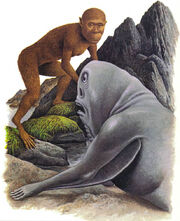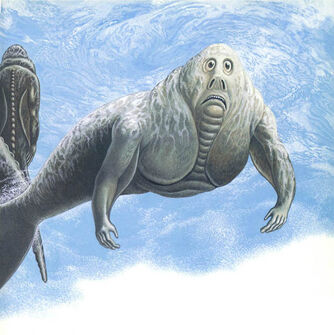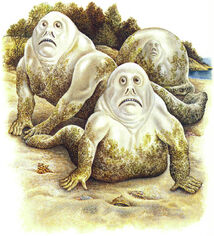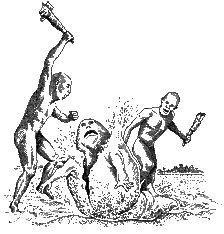
This aquatic rests on the coast while a curious forest dweller inspects the being
The Aquatic (Piscanthropus submarinus) is one of the 5 genetically modified base species of posthumans that appear in the book Man after man, developed to inhabit the aquatic environment, presenting many more marked adaptations than its indirect ancestor the Aquamorph with a high modified morphology and the ability to reproduce. This is chronologically speaking the first species capable of surviving on its own and it turns out to be the last posthuman lineage to survive after the mass extinction of 5 million years in the future.

This creatures is characterized for possessing a quite robust and wide body, head and chest, the hindlimbs have modifiend in a long tail that finishes in a flat delta shaped fluke. Its oval head has a flat face with huge glassy eyes like those of a fish, being these unable to perceive color light, a rather reduced and atrophied nose that is only formed by the nasal openings and a large and wide mouth. This has a series of pectoral gills which were added with the purpose of making it dependent on aquatic life without the need to breath air, a minor legacy of its Aquamorph predecessor. The two arms still have the original arm structure of their ancestor including a hand with fingers, however it has two paddle-like extensions on the sides that together form a fin for swimming.
History[]
Unlike other human species, aquatics emerged at an earlier time in history, specifically in the final days before genetic engineering project closed after the interstellar migration finished. These were a successor of the Aquamorph, although these were mostly modified to be better adapted to their environment and with the addition of being able to generate offspring. 100 years later, these become the long predominant organisms of the ocean with the emptiness caused by the mass extinction, living on the seabed and for the next million years would be the only large animal, suffering an exponential population growth with the lack of competition and available food.

As the resources become scarce, aquatics tried to return to the land in orden to find more food and mantain their population, taking a inusual adaptation to stay on land
Around 50000 years in the future, a drastic change in the global climate that warmed the planet, leading to the melting of the glacial layers, and with it rising sea levels, has led to a disrupt of in the amount of food and resources in the ocean which affected the fairly widespread aquatic population. Therefore, they were pressured to venture ashore and with that these developed a mucous cover bubble that was modified over time making it become more attached to the body as a type of suit, this to harvest the resources around the coasts, however these came into conflict with other human species for such resources.

The boat people tend to have conflict with the collector aquatics which ended up always in fatal encounters
At 5 million years they abandoned this lifestyle of coastal collectors and returned to the life of the ocean when it returned to a sustainable state, being the dominant megafauna animal of all oceans without divergent species unlike the other base forms until that point. All this, however, would end with the arrival of the travelers of the stars and the subsequent terraforming of the planet that led this species to extinction, but unlike all the terrestrial Posthumans, they were the only ones to generate offspring that survived extinction, the P. profundus, a deep water dwellers which survived in the abyssal parts of the planet, with the potential to re-colonize the planet in the distant future.
